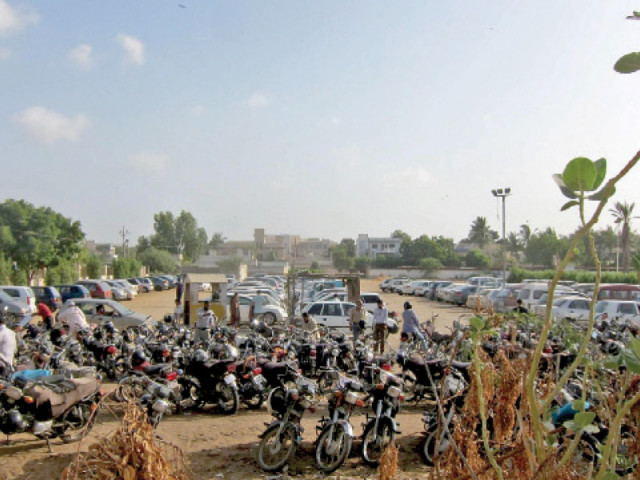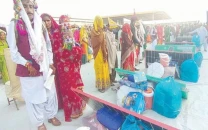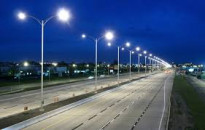Public nuisance: When KMC is renting out footpaths, how can encroachments go away?
Shehri takes a 360-degree view of Karachi’s shrinking public spaces.

As long as political parties, the Karachi city government, police, land-owning agencies, traders and shopkeepers are guilty of encroachments there is no chance of removing them in the city unless its residents develop an educated view of safety and aesthetics.
This was the take-home message from a consultative workshop organised by Shehri-Citizens for a Better Environment on Thursday. The aim was to profile the growing menace of urban encroachment and highlight how it affects all people in Karachi whether it is at their door step, in their markets or on their pavements.

The city’s stakeholders were invited from the traffic police department to the Karachi Metropolitan Corporation’s anti-encroachment cell, lawmakers, urban planners and members of different non-government organisations.

Shehri’s Amber Alibhai gave pictorial examples of encroachments on government land, public roads, streets and pavements backed by the patronage of the police and political parties. “Unfortunately, the government policy is to enable or facilitate the government for its own interest,” she said. There are two types of land affected by encroachments: one is land that is assessed by the revenue authorities and is for private occupation, and the other is not assessed by the revenue department, such as roads, parks, playgrounds, footpaths and pavements, water courses, nullahs.
“Unfortunately, the media pays attention when the anti-encroachment team removes the encroachments from assessed lands but not when it comes to assessed land occupation, which is criminal in nature [too],” she said.

She was critical of the KMC anti-encroachment department, which was itself selling footpaths and pavements to generate revenue. The shrinking public space has reached a tipping point, and there is an immediate need for a centralised land-use policy, she said. “Ziauddin hospital has also extended its boundary and made a playground its car park,” she said, giving an example of how a well-respected institution does the same thing. A nullah in KAECHS Society has been taken over by a K-Electric substation, which is the main reason why the area continues to flood during the rainy season.
Encroachments qualify as a “public nuisance” because they are an activity that threatens public safety, health, welfare or causes damage to community resources. The safety of pedestrians and road users is compromised and put at risk by illegal parking, extension of shops, and the reduction of safe walking passages, for example. “Displaying goods for sale, or the occupation of amenity plots by changing their designated usage as defined in the master plan also counts as public nuisance,” she said. “Political parties, the KMC, police, land-owning agencies, association of traders, business shopkeepers are guilty of this crime.”

Population versus planning
Farhan Anwar of Sustainable Initiatives highlighted how the city’s population has increased in different phrases, but the planning mechanism has not changed accordingly. Planning process for urban infrastructure has failed due to an absence of continuity, absence of implementation and financial mechanisms, absence of political mandate and absence of stakeholder consultations.
“Failed planning created a powerful and influential developers lobby, put a stress on civic infrastructure and created vertical slums,” he said. “Due to the stress on civic infrastructure public parks and footpaths have been encroached on by car showrooms, restaurants, petrol pumps, CNG stations.”
During a survey, it emerged that 86% of people in the city do not need the encroachment or commercialisation in their area but do not want to take action as they know it is fruitless and no government would take action against the encroachers, he said. “In the absence of a strong city government, Karachi is being run on an ad hoc basis with multiple stakeholders safeguarding their own interests,” he said. “The lack of centralised mechanism in the city can be gauged by the fact that when there was a fire emergency last month during the Jinnah airport attack, the army had to come to douse the fire.”
Shehri’s Dr Raza Ali Gardezi spoke of the commercialisation policy of 2003 in which the city’s 25 big streets were commercialised. He said that in accordance with the Sindh Local Government Ordinance, 2013 footpaths and public spaces will be maintained without obstruction to public use, but unfortunately the government departments, including the law enforcers, traffic police, KMC, DHA and KPT are not fulfilling their responsibility to rid the city from this menace.
Political influence
The Urban Resource Centre’s Zahid Farooq, MNA Dr Arif Alvi, MPA Hafeezuddin Advocate, KMC director for anti-encroachment Mazhar Khan, Traffic DSP Sagheer Jafery also spoke.
Alvi, Hafeezuddin and Farooq highlighted the failure of government institutions and the use of political influence to occupy amenity plots, playgrounds, parks and designated health facilities. Mazhar Khan and Jafery blamed each other for the encroachments. “Our most respected comrade Nisar Baloch and Perween Rahman were shot dead when they were raising their voice against encroachments,” said URC’s Zahid Farooq.
Alvi said most of city’s amenity plots have been encroached on in the name of China cutting. “We cannot avoid political involvement when it comes to encroachments,” he added. However, Mazhar Khan said that without the police’s help, KMC cannot remove encroachments. He denied that political parties were involved in encroachments. “The government should provide us at least 200 police officials so that we continue our drive,” he said, lamenting that it was not a priority with the police. “We demolished encroachments at least 18 times in Saddar but the traffic police did not do its job and they came back,” he said.
DSP Sagheer Jafery said that during the British Raj an anti-encroachment act was implemented but it is now useless. The government must amend the laws if they want to make the police an active force against encroachers.
Published in The Express Tribune, July 20th, 2014.



















COMMENTS
Comments are moderated and generally will be posted if they are on-topic and not abusive.
For more information, please see our Comments FAQ